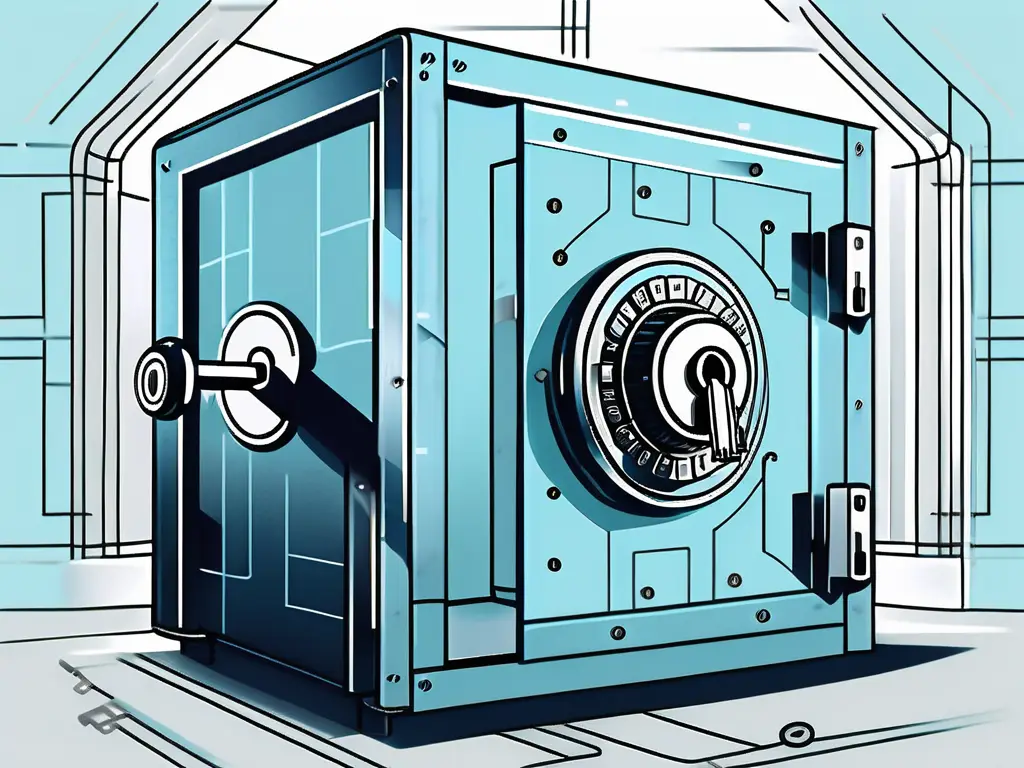With the constant threat of hackers and data breaches, organizations always look for ways to keep their sensitive information safe. One such solution is the Key Management Interoperability Protocol or KMIP. But what exactly is KMIP? This article will explore the basics of KMIP, its architecture, benefits, and future trends to help you understand its importance in cybersecurity.
Understanding the Basics of KMIP
Before diving into the details, let’s start with the definition and purpose of KMIP. At its core, KMIP is a communication protocol that standardizes the interaction between key management systems and cryptographic devices. It provides a unified approach to key management, allowing organizations to centrally manage cryptographic keys and policies across multiple devices and vendors. The primary goal of KMIP is to ensure interoperability and ease of integration between different key management systems, eliminating the need for complex integrations and reducing operational overheads.

In today’s digital landscape, where organizations rely heavily on encryption to protect their sensitive data, key management plays a pivotal role in cybersecurity.
The Importance of Key Management in Cybersecurity
Picture this: You have a state-of-the-art locking mechanism to secure your house, but you have a hundred keys for different doors. How do you keep track of all those keys? This is where key management comes into play. In cybersecurity, encryption ensures data is securely encoded, making it unintelligible to unauthorized users. However, encryption is only as strong as the management of its keys. Without proper key management, the entire encryption system can be rendered useless.
Key management involves generating, storing, distributing, and revoking encryption keys. It provides the foundation for strong cryptography and ensures that only authorized individuals can access the encrypted data. Effective key management practices help organizations maintain their sensitive information’s confidentiality, integrity, and availability.
Let’s delve deeper into the different aspects of key management. The first step is key generation. This process involves creating mathematically complex and secure cryptographic keys. Key generation algorithms use random number generators to generate unique keys that are virtually impossible to guess or replicate. These keys serve as the foundation for encryption and decryption processes.
Once the keys are generated, they need to be securely stored. Key storage is critical to key management, as the keys must be protected from unauthorized access. Organizations employ various methods to store keys securely, such as hardware security modules (HSMs) or secure key vaults. These storage mechanisms ensure the keys are safeguarded from physical and logical attacks.
Key distribution is another crucial aspect of key management. When encryption is used in a distributed environment, such as cloud computing, the keys need to be securely distributed to the relevant parties. This process involves securely transmitting the keys to authorized individuals or systems, ensuring they can access the encrypted data when needed.
Lastly, key revocation is an essential part of key management. In certain situations, such as when a key is compromised or when an employee leaves an organization, it becomes necessary to revoke a key’s access privileges. Key revocation ensures that any encrypted data associated with the revoked key remains secure and inaccessible.
By implementing robust key management practices, organizations can mitigate the risks associated with unauthorized access to sensitive data. Effective key management protects against data breaches and helps organizations comply with regulatory requirements related to data protection and privacy.
The Architecture of KMIP
Now that we understand the basics and importance of KMIP, let’s delve into its architecture. KMIP is designed as a layered protocol, with each layer responsible for a specific set of functions. The components that make up the protocol are at the core of the KMIP architecture.
Components and Structure of KMIP
The KMIP architecture consists of three main components: the client, the key management server, and the cryptographic device. The client is responsible for initiating key management operations and communicating with the key management server, which acts as the central authority for managing cryptographic keys and policies. Finally, the cryptographic device is the hardware or software that performs cryptographic operations.
These components work together to establish a secure and interoperable environment for cryptographic key management. The KMIP protocol uses a message-based structure, allowing the client and server to exchange key management operations and information. This structure ensures that key management operations are executed accurately and efficiently.
How KMIP Works: An Overview
Now that we have a high-level understanding of the KMIP architecture, let’s explore how KMIP works in practice. The key management process typically begins with the client requesting a specific operation, such as generating or retrieving a key, from the key management server.
The client sends the request to the server using the KMIP protocol. The server processes the request and executes the requested operation. It then sends the response back to the client, containing the operation’s result. Throughout this process, the KMIP protocol ensures the security and integrity of the communication between the client and the server, protecting the confidentiality of the exchanged keys and policies.
Within the KMIP architecture, additional layers contribute to the overall functionality and security of the protocol. One such layer is the authentication layer, which ensures that only authorized clients and servers can access and perform key management operations. This layer employs various authentication mechanisms, such as digital certificates and secure tokens, to verify the identities of the entities involved.
Another important layer is the encryption layer, which safeguards the confidentiality of the data transmitted between the client and the server. This layer uses strong encryption algorithms to encrypt the key management operations and information, making it virtually impossible for unauthorized parties to decipher the content.
The KMIP architecture incorporates a key lifecycle management layer, which governs the entire lifecycle of cryptographic keys. This layer includes key generation, distribution, storage, rotation, and destruction, ensuring that keys are properly managed throughout their lifespan. By implementing a comprehensive key lifecycle management process, KMIP minimizes the risk of key compromise and strengthens the overall security posture.
Benefits of Using KMIP
Enhancing Security with KMIP
Security is the cornerstone of any successful cybersecurity strategy. By implementing KMIP, organizations can enhance the security of their cryptographic keys.
KMIP provides a standardized approach to key management, ensuring that keys are generated, stored, and distributed securely. This eliminates the risk of key leakage and unauthorized access to sensitive data, mitigating the impact of potential data breaches.
But what sets KMIP apart is its ability to enforce consistent security policies across different cryptographic devices. With KMIP, organizations can define and enforce policies for key strength, expiration, and usage restrictions. This means that even if you have multiple devices from different vendors, KMIP ensures that the same security policies are applied uniformly.
Imagine an organization with different cryptographic devices with varying key strengths and expiration dates. This can create a significant security vulnerability, as malicious actors can exploit weak or expired keys. However, with KMIP, organizations can establish a unified security standard, reducing the risk of weak or misused cryptographic keys compromising their security posture.
KMIP’s Role in Interoperability
Interoperability is another key benefit of using KMIP. In today’s heterogeneous IT environments, organizations often use various cryptographic devices and vendors.
Managing keys across these devices can be a complex and time-consuming task. However, KMIP solves this problem by providing a standard protocol for key management, enabling seamless interoperability between cryptographic devices and vendors.
By adopting KMIP, organizations can simplify their key management processes and reduce the need for custom integrations. This streamlines operations, reduces costs, and minimizes the chances of compatibility issues that can arise when using different key management systems.
Imagine the time and effort saved when organizations can easily manage cryptographic keys across different devices and vendors, without the need for complex integrations or custom solutions. KMIP’s interoperability capabilities ensure that organizations can focus on their core business objectives, rather than getting caught up in the complexities of key management.
KMIP and Other Key Management Standards

Comparing KMIP with Other Protocols
One of the most well-known key management standards is the Key Management Service (KMS) provided by Amazon Web Services (AWS). While KMS offers robust key management capabilities within the AWS ecosystem, it is specific to AWS and does not provide the same level of interoperability as KMIP.
On the other hand, KMIP is an industry-wide standard supported by several major vendors, making it a more versatile and widely adopted solution. KMIP’s focus on interoperability allows organizations to manage keys across different vendors and technologies, providing greater flexibility and choice.
Another key management standard worth mentioning is the Public Key Cryptography Standards (PKCS), developed by RSA Security. PKCS offers a comprehensive set of standards for secure key management, including formats for keys, certificates, and cryptographic messages. While PKCS is widely used in the industry, it may not offer the same level of vendor-agnostic interoperability as KMIP.
Why Choose KMIP Over Other Standards
When choosing a key management standard, it is important to consider your organization’s specific needs and requirements. While other standards may excel in certain areas, KMIP stands out with its emphasis on interoperability and ease of integration.
Organizations adopting KMIP can future-proof their key management infrastructure, ensuring compatibility with various cryptographic devices and vendors. This versatility allows organizations to choose the best-in-class solutions for their specific use cases, without being locked into a single vendor or technology.
Ultimately, choosing KMIP over other key management standards will depend on organizational requirements, existing technology stack, and long-term strategic goals. It is essential to evaluate the pros and cons of each standard carefully to make an informed decision that aligns with your organization’s key management needs.
Implementing KMIP in Your Organization
Implementing KMIP involves several steps to ensure a smooth and successful implementation:
- Evaluate your organization’s key management needs and requirements.
- Research KMIP-compliant key management systems and vendors that align with your needs.
- Develop a comprehensive implementation plan, including timelines, resource allocation, and potential challenges.
- Train your IT team and key stakeholders on the use and benefits of KMIP.
- Engage with vendors and consultants to assist with the implementation process.
- Perform thorough testing and validation to ensure the proper functioning of the KMIP implementation.
- Monitor and evaluate the effectiveness of KMIP in meeting your organization’s key management objectives.
When evaluating your organization’s key management needs and requirements, it is important to consider factors such as the size of your organization, the sensitivity of your data, and any regulatory compliance requirements. By understanding these factors, you can better determine the level of key management functionality and security measures needed.
Researching KMIP-compliant key management systems and vendors is crucial to finding the right solution for your organization. Look for vendors that have a proven track record in the industry and offer features that align with your specific needs. Consider factors such as scalability, ease of integration, and ongoing support when deciding.
A comprehensive implementation plan is essential to ensure a smooth transition to KMIP. This plan should outline the key milestones, timelines, and resource allocation required for the implementation. It should also address potential challenges and provide contingency plans to mitigate any risks that may arise.
Training your IT team and key stakeholders on the use and benefits of KMIP is vital for successful adoption. This training should cover topics such as key management best practices, encryption algorithms, and the role of KMIP in enhancing data security. By equipping your team with the necessary knowledge, you can maximize the benefits of KMIP within your organization.
Engaging with vendors and consultants can provide valuable expertise and guidance throughout the implementation process. These professionals can assist with system integration, configuration, and troubleshooting, ensuring a smooth and efficient implementation.
Thorough testing and validation are crucial to ensuring the proper functioning of the KMIP implementation. This includes testing key management operations, encryption and decryption processes, and access controls. You can identify and address any potential issues before fully deploying KMIP within your organization by conducting rigorous testing.
Monitoring and evaluating the effectiveness of KMIP in meeting your organization’s key management objectives is an ongoing process. Regularly assess the performance of the key management system, gather feedback from users, and make necessary adjustments to optimize its functionality. By continuously monitoring and evaluating KMIP, you can ensure it remains aligned with your organization’s evolving needs and objectives.
Considerations for Successful KMIP Implementation
While implementing KMIP can bring significant benefits to your organization, it’s essential to consider certain factors to ensure a successful implementation:
- Choose a KMIP-compliant key management system that aligns with your organization’s specific needs and integrates seamlessly with your existing infrastructure.
- Define clear goals and objectives for your KMIP implementation, ensuring alignment with your overall cybersecurity strategy.
- Work closely with your key management system vendor and IT team to ensure smooth integration and minimize potential disruptions.
- Regularly update and review your key management policies and procedures to adapt to changing security requirements and best practices.
Choosing a KMIP-compliant key management system that aligns with your organization’s specific needs is crucial for a successful implementation. Consider the system’s scalability, flexibility, and compatibility with your existing infrastructure. By selecting the right system, you can ensure a seamless integration process and minimize any potential disruptions.
Defining clear goals and objectives for your KMIP implementation is essential to ensure alignment with your cybersecurity strategy. Identify the specific outcomes you want to achieve with KMIP, such as improving data protection, enhancing compliance, or streamlining key management processes. By setting clear goals, you can measure the success of your implementation and make informed decisions to optimize its effectiveness.
Working closely with your key management system vendor and IT team is crucial to ensure a smooth integration process. Collaborate with your vendor to understand the system’s capabilities, implementation requirements, and potential challenges. Engaging your IT team throughout the process will help address technical considerations and ensure a successful implementation.
Regularly updating and reviewing key management policies and procedures is vital to adapting to changing security requirements and best practices. As cybersecurity threats evolve, it is essential to stay proactive and ensure that your key management practices remain effective. Review your policies, procedures, and controls regularly to identify gaps or improvement areas.
By considering these factors and following the steps outlined, you can successfully implement KMIP within your organization and enhance your key management capabilities. Remember, KMIP is a powerful tool that can significantly improve data security and streamline key management processes, ultimately contributing to the overall success of your organization.
Future of KMIP
As technology continues to evolve, so does the field of key management. Let’s examine some emerging trends in key management and how KMIP is shaping the future of cybersecurity.
Emerging Trends in Key Management
As organizations increasingly adopt cloud-based solutions and hybrid IT environments, key management is evolving to meet these new challenges. Key management as a service (KMaaS) is gaining traction, offering organizations a scalable and flexible approach to key management. With KMaaS, organizations can outsource their key management functions to specialized providers, ensuring the security and integrity of their cryptographic keys.
How KMIP is Shaping the Future of Cybersecurity
KMIP’s focus on interoperability and standardization positions it as a key player in the future of cybersecurity. As organizations embrace digital transformation and adopt new technologies, seamless key management becomes even more critical. KMIP’s ability to integrate with a wide range of cryptographic devices and vendors ensures that organizations can easily and confidently navigate the evolving cybersecurity landscape.
Conclusion
KMIP is a powerful protocol that enables organizations to manage their cryptographic keys in a standardized, interoperable, and secure manner. Organizations adopting KMIP can enhance their cybersecurity posture, simplify key management processes, and future-proof their key management infrastructure.
Whether protecting customer data, safeguarding intellectual property, or securing government secrets, KMIP provides a foundation for effective key management practices. By embracing KMIP, organizations can stay one step ahead of cyber threats and ensure their most sensitive data’s confidentiality, integrity, and availability.
As you consider the pivotal role of KMIP in enhancing your organization’s cybersecurity posture, remember that the journey toward robust digital protection doesn’t end here. Blue Goat Cyber, a leader in cybersecurity excellence, stands ready to guide you through the complexities of key management and beyond. With our comprehensive B2B services, including medical device cybersecurity, penetration testing, and HIPAA and FDA standards compliance, we are committed to securing your business against ever-evolving cyber threats. Our veteran-owned, USA-based team offers customized, state-of-the-art cybersecurity solutions tailored to your unique needs. Contact us today for cybersecurity help, and let us be your partner in safeguarding your digital ecosystem and empowering your business to thrive in the digital landscape.


